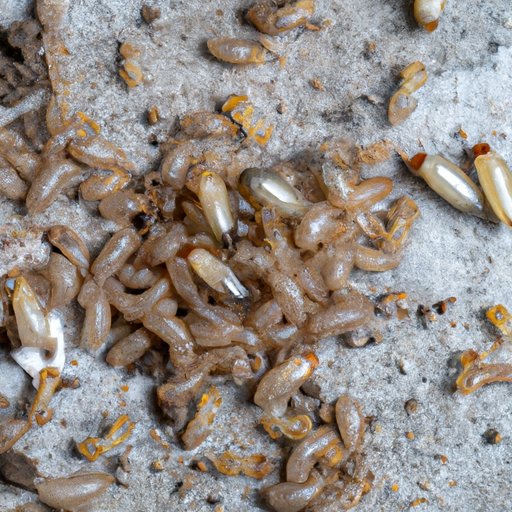
I. Introduction
Termites are one of the most destructive pests to homes and buildings, causing billions of dollars in damage every year. Identifying and managing termite infestations is crucial to protecting your property and maintaining its value. In this article, we will explore the signs of termite infestation, inspecting for termites, factors that attract termites, preventative measures, DIY treatment options, hiring a professional pest control company, and long-term prevention strategies.
II. Signs of Termite Infestation
Termites are often called “silent destroyers” because they can cause extensive damage while remaining unseen. However, there are several signs of termite infestation to be aware of.
- Visible damage to wood: Look for wood that appears to be hollowed out, with long grooves or holes.
- Mud tubes: These are small tubes made of dirt, wood, and termite saliva, which termites use to travel from their colony to food sources.
- Discarded wings: After swarming, termites shed their wings, which are often found near windowsills or other areas where they may have gained access to your home.
III. Conducting a Termite Inspection
It’s important to regularly inspect your home for signs of termite infestation, particularly if you live in an area with high termite activity. Here’s how to perform a termite inspection on your own:
- Tools to use: You’ll need a flashlight, a screwdriver, and a sharp object like a knife or ice pick to poke at wood.
- What to look for: Inspect the foundation of your home, especially where it meets the ground. Check for mud tubes, termite damage to wood structures, and signs of swarms.
IV. Factors That Attract Termites
Termites are attracted to areas with moisture and cellulose materials (like wood). Here are some factors that can encourage termite activity:
- Moisture: Termites thrive in damp environments, so areas with excess moisture (like leaky pipes or poor drainage) can be attractive to termites.
- Wood-to-ground contact: Wooden structures that directly touch soil provide easy access for termites to enter.
- Other factors: Cracks in foundations, improperly installed vents, and piles of leaves or wood debris can all attract termites.
V. Importance of Preventative Measures
Preventing termite infestations is vital to protecting your property and avoiding expensive repairs. Here are some preventative measures you can take:
- Regular property maintenance: Keep your property well-maintained, with no wood debris or piles, and proper drainage to avoid excess moisture.
- Installing termite barriers: These barriers can be installed around the perimeter of your home and require professional installation.
- Other preventative strategies: Using termite-resistant building materials, keeping firewood and other wooden structures away from your home, and sealing cracks and holes in your foundation can all help prevent termite infestations.
VI. DIY Termite Treatment
If you’ve confirmed a termite infestation, there are some DIY treatments you can try before calling a professional. However, keep in mind that these treatments may not be effective for severe infestations and that calling a professional is often the better choice. Here are some tips for treating termites on your own:
- Spot treatment: If you’ve found an area with termite activity, you can apply insecticide to the wood directly.
- Bait stations: Bait stations can be placed around your property to lure termites and then kill them with insecticide.
- When it’s appropriate to try DIY treatments: DIY treatments are best for small, localized infestations. If you have a severe infestation or have been unable to get rid of termites on your own, it’s time to call in the professionals.
VII. Hiring a Professional Pest Control Company
Professional pest control companies have the expertise and tools needed to effectively treat termite infestations. Here are some benefits of hiring professionals:
- Expertise: Pest control professionals have the knowledge and experience to accurately identify and treat termite infestations.
- Effective treatment: Professionals have access to stronger insecticides and can use advanced treatment methods like fumigation.
- What to look for: When choosing a pest control company, look for one with experience in treating termites, good customer reviews, and appropriate licensing and certifications.
VIII. Long-term Prevention Strategies
After treating a termite infestation, it’s important to take ongoing preventative measures to avoid future infestations. Here are some long-term prevention strategies:
- Ongoing maintenance and inspections: Regularly inspect your property for signs of termite activity and keep up with property maintenance to avoid excess moisture and wood debris.
- Considerations for termite-resistant construction: If you’re building a new home or doing renovations, consider using termite-resistant materials and construction techniques.
- Other strategies for avoiding future termite infestations: Keep firewood away from your home, seal cracks and holes in your foundation, and use termite-resistant mulch around landscaping.
IX. Conclusion
Termites can cause extensive damage to your property, but with proper prevention and treatment, you can prevent infestations and protect your investment. Remember to regularly inspect your home for signs of termite activity, take preventative measures, and call in a professional if necessary. By taking action to manage and prevent termite infestations, you can avoid costly repairs and keep your home safe and secure.





